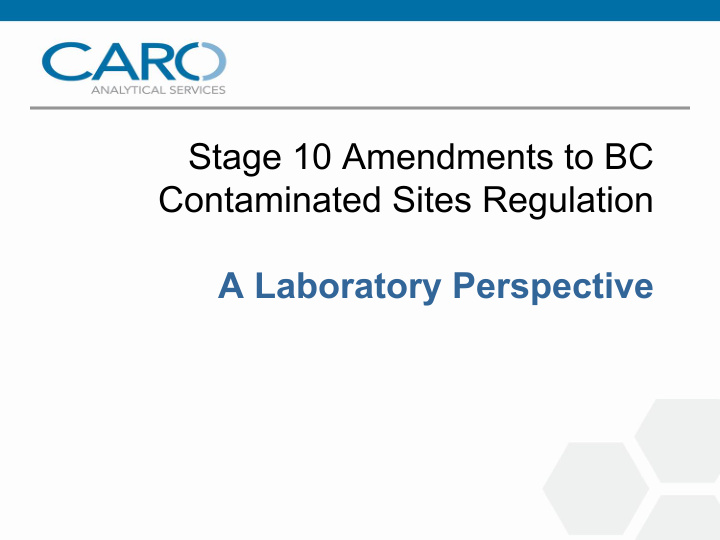



Stage 10 Amendments to BC Contaminated Sites Regulation A Laboratory Perspective
Overview 1. Background: What does this mean for the environmental testing industry? 2. Revisions to Existing Standards 3. New and Emerging Compounds 4. Industry Response
What Does this Mean? At least 1/3 of CARO’s analytical work is related to the BC Contaminated Sites (CSR) regulation
Main CSR Tests Three parameter groups represent ~80% of CSR testing: – Semivolatiles: EPH, PAH, L/HEPH (30%) – Metals (30%) – Volatiles: VH, BTEX, VOC (20%) – Others: Phenols, PCB, Salt, General Parameters (20%)
BCELTAC British Columbia Environmental Laboratory Technical Advisory Committee – Industry partnership with the BCMOE – CARO involvement 10+ years – Method authorship: • Prescribed: strict adherence required, e.g. SALM • Performance-based: deviations allowed, e.g. VH Standardized provincial methods = laboratory alignment
BCELTAC Engagement : • LEPH/HEPH/VPH: co-reporting requirements • August 28 Letter to BCMOE: BCELTAC Recommendations and Comments re: Stage 10 Amendments • 15 Recommendations
Detection vs Reporting Limits Method Detection Limit (MDL): Statistically derived (best case scenario) – high uncertainty (>100%) Reporting Limit (MRL, RL, RDL): Based on Reality (typically 2-3x MDL) – medium uncertainty (<100%) GOAL: Default RL below CSR Standard, ideally 5x lower - allows for moisture corrections, interferences and low uncertainty at the concentration of the standard (<50%) A lower MRL is not necessarily better
Revisions to Existing Standards Why? Based on most recent science, alignment with other jurisdictions (CCME, EPA) 1. Standard is adjusted: – Possibly lowered: PAHs, VOCs, Metals – Raised: Lab would likely leave method (MRL) as-is 2. Standard is redefined: – Total Non-Chlorinated Phenols à Individual Standards – Total PCB: Four Aroclors à Nine Aroclors – PAH: Benzo(b)fluoranthene and Benzo(k)fluoranthene combined
Emerging Contaminants of Concern Broadly defined as any synthetic or naturally occurring chemical or any microorganism that is not commonly monitored in the environment but has the potential to enter the environment and cause known or suspected adverse ecological and(or) human health effects. Examples: • Alkylated PAHs: C3-fluoranthenes/pyrenes • Antimicrobials: Triclosan • Endocrine Disruptors: Bisphenol A • Flame Retardants: PBDEs • Pharmaceutical and Personal Care Products
How do Emerging Contaminants Differ? Chemical properties – Many isomers and degradation products – Higher solubility in water – Ubiquitous – prone to contamination Economics – Expensive instrumentation & standards è costly – Can be time consuming è higher TATs – Lower demand è costly Contaminated Sites vs. Environmental Monitoring
Examples of Priority Compounds Antimicrobials (Triclosan, Triclocarban) • Usage: antibacterial soaps, medical industry • Problem: promote resistance to antibiotics • Instrumentation: LC-MS/MS (0.05 µ g/L) ü Hormones (17a-ethinylestradiol): • Usage: contraceptive • Problem: endocrine disruptor • Instrumentation: LC-MS/MS (0.002 µ g/L) ü
Examples of Priority Compounds Alkylated PAHs • Usage: none (PAH degradation products) • Problem: bioaccumulation (worse than parent PAHs) • Instrumentation: GC-MS (<1 µ g/L) or GC-MS/MS ü Others: • Perfluorinated Substances (PFOS) – LC-MS/MS • Detergents (Nonylphenol, Octylphenol) – LC-MS/MS • Polybrominated Diphenyl Ethers – High Resolution GC/MS
What does this mean for BC Labs? BCELTAC: • BCMOE to provide proposed standards in Dec/Jan • Ensure that standard is achievable by multiple labs • May need to revise or create new provincial method Individual Labs: • May need to revalidate existing method • May validate new method(s) to meet demands • Will need to update their Scope of Accreditation
Recommend
More recommend